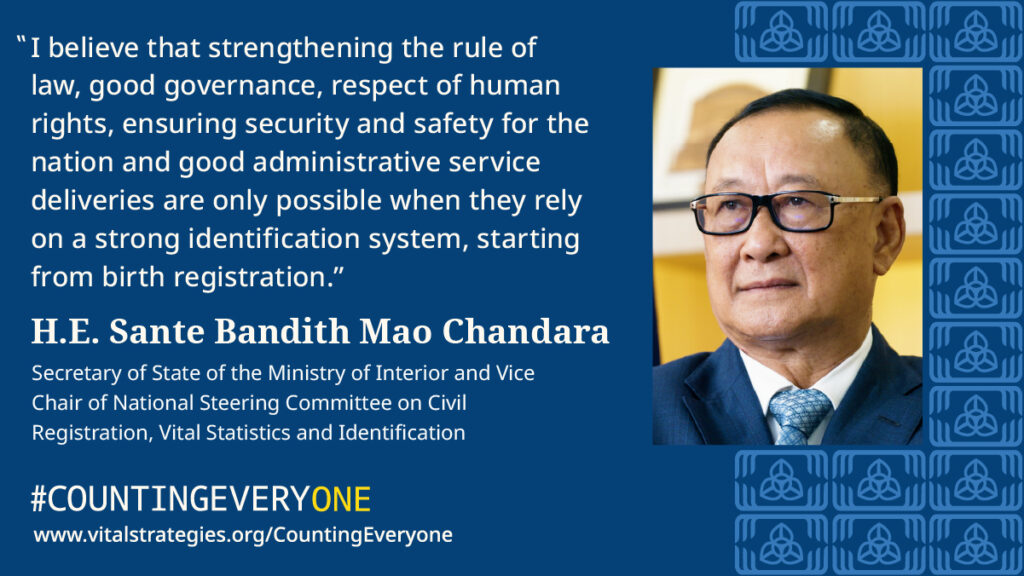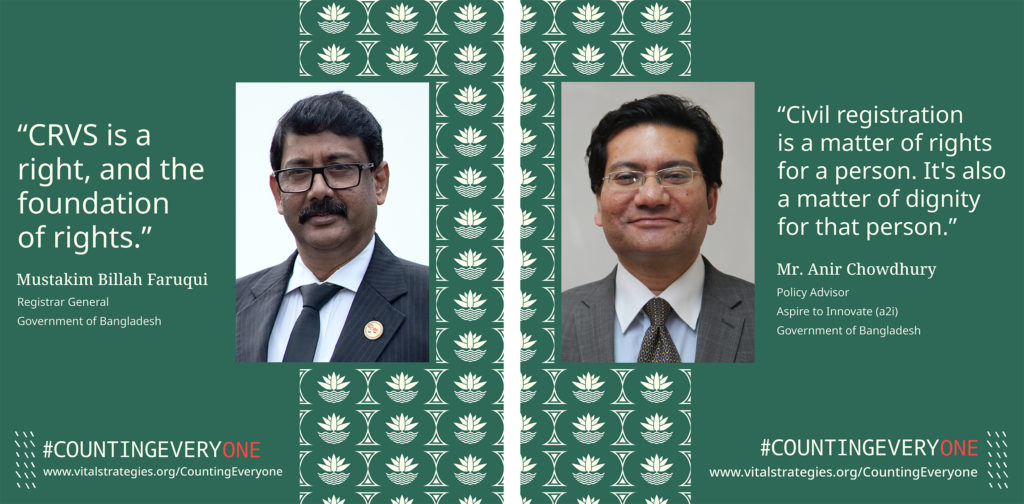
For the first time, counting every life is possible—even in the world’s most remote locations. Leadership in countries worldwide, advances in systems thinking, demographic analysis and digital technologies are informing accelerated improvements to civil registration and vital statistics (CRVS) systems, which are at the foundation of good governance.
Well-coordinated CRVS systems have the unique power to benefit every individual and inform public policy simultaneously. Behind every vital statistic is a person, a family and a community. While having a personal identity is a given, possessing a legal identity is not. A legal identity is conferred through civil registration systems—which aim to register every birth and death and assign causes of death.
With universal access to legal identity and the means to prove it, children and adults can access government services. At the same time, with complete data, governments can account for their entire populations in public policy development and planning—including for groups previously left out of official statistics. The civil registration and statistical analysis of deaths and cause of death provide data unavailable from any other source. Knowing how many people die and what they die from should be at the root of evidence-based policy priorities—creating the environment for a country’s population to live longer and healthier lives.
The U.N. Sustainable Development Goals call for 100% of births and 80% of deaths to be registered globally by 2030 — recognizing the importance of civil registration and its part in building an equitable and healthier world. Empowering every human to be seen, to be acknowledged, is at the heart of this effort.
The #CountingEveryone campaign was created to inspire those in positions of leadership and authority to champion the improvement and scaling of CRVS systems to the benefit of all, and to foster the kind of inter-sectoral coordination inherent in effective CRVS governance. The campaign shines a light on the role that leaders, leadership and coordination are playing in accomplishing country-level improvements to CRVS systems around the world.
Cambodia
Cambodia’s new law on civil registration guarantees a legal identity for all residents—a key to unlocking education, health care, and many other social benefits and protections. Taking effect in July 2024, the landmark “Law on Civil Registration, Vital Statistics and Identification” calls for a modern, integrated CRVS system that requires compulsory registration of all births, deaths and other vital events.
The law represents a critical step toward counting everyone. Not only does it confer rights to individuals, but it also equips policymakers with crucial data—including patterns of mortality and causes of death—to build more effective and equitable public health and development policies.
Since 2017, Vital Strategies has been working with the Cambodian government and other partners, providing technical assistance ranging from building capacity of medical professionals and data analysts to enhance civil registration processes, to improving data collection and its use toward evidence-based policy decisions.
In the six years since this collaboration began as part of the Bloomberg Philanthropies Data for Health Initiative, birth registration rates in the country have more than doubled, and death registration rates are increasing significantly—testimony to the commitment and leadership of the national government. The new regulations equip Cambodia to realize the U.N. Sustainable Development Goal target 16.9 of achieving universal birth registration and 80% of deaths to be registered by 2030.

Kenya
By using innovative approaches and adapting digital technology, Kenya has been able to significantly improve its civil registration and vital statistics (CRVS) systems in recent years. After assessing the country’s CRVS systems and the various agencies involved, Kenya took on the task of digitizing a previously part-digital, part-paper-based system.
In 2019, 32 million birth and death registration records were digitized within a month. This shift has led to an increase the accuracy and timeliness of birth and death registration. In 2021, Kenya achieved 86.2% of birth registration and 55.4% of death registration. The number of Civil Registration Services offices across the country has also increased from 109 in 2017 to 131 in 2022.
Watch our video below and read our Vital Stories blog: #CountingEveryone Campaign Gains Traction in Kenya

Viet Nam
In 2017, the Prime Minister of Viet Nam advanced the National Action Programme on Civil Registration and Vital Statistics (CRVS), a key effort to bring together and coordinate CRVS stakeholders. By sharing data and statistics among sectors—particularly those relating to births, deaths and causes of death—government agencies can streamline the policymaking process, protect people’s health and ensure that other rights and interests are honored, as stipulated by law.
A user-friendly digital system now allows parents to quickly register their newborn, and is linked directly to the national ID and health insurance systems. Viet Nam’s birth registration rate reached 98.1% following the implementation of the online system in 2016.
Death registration improvement is ongoing. With only 14% of deaths occurring in health facilities, the vast majority of deaths happen in the community. The country has made efforts to educate and implement better pathways to record the cause of death—aiming to reach 80% medical certification of cause of death for all fatalities by 2024.
Strengthening CRVS governance and its legal framework, and introducing digital solutions, will further improve Viet Nam’s CRVS processes and capacity. Mr. Nguyen Cong Khanh, Director of Civil Registration, Nationality, Attestation Department, Ministry of Justice, is one of the CRVS champions driving Viet Nam’s commitment to #CountingEveryone.

Colombia
Through the forward-looking adoption of new strategies and technologies, Colombia has created one of the most complete civil registration and vital statistics (CRVS) systems in Latin America. Close collaboration between Colombia’s National Administrative Department of Statistics and the Ministry of Health and Social Protection, which oversees the health-related aspects of vital statistics, has produced a model for near-universal access to CRVS services.
With an innovative use of text messaging to officially report births and deaths, as well as e-learning to strengthen the capacity of professionals and vital statistics administrators in civil registration and proper cause of death certification, the country has made sustainable and valuable advances. One of the government’s main efforts to leave no one uncounted, the Colombia Rural Vital Strategy, ensures the inclusion of historically excluded and hard-to-reach communities.

Meet two CRVS champions from the Government of Colombia:
Dr. Edna Margarita Valle Cabrera is Vital Statistics Coordinator at the National Administrative Department of Statistics (DANE), and Dr. Victor Hugo Alvarez Castaño is Advisor for the Ministry of Health and Social Protection’s Directorate of Epidemiology
Rwanda
Rwanda’s barriers to civil registration are being dismantled by digitizing and decentralizing its CRVS services. Rwandans may now register births and deaths close to home, instead of making long and expensive journeys to previously distant registration centers.
The demands of implementing the decentralized system in Rwanda called on stakeholders to leverage existing structures collectively and collaboratively. This enhanced coordination has accelerated improvement and begun to increase completeness in the country’s CRVS system. The decentralization effort has also been aided by the introduction of CRVS technology that is compatible with other systems, including those for producing reliable cause of death statistics from health facilities and from communities. Public communication and participation are also a priority for the government: during the country’s annual CRVS Awareness Week, advertising campaigns draw residents to facilities where registration services are provided to individuals who have previously neglected to register birth or deaths.
CRVS system champions within the Rwandan government were instrumental to increased buy-in at all levels, and encouraged strong collaboration and shared understanding of roles and responsibilities throughout.

Meet two CRVS champions from the Government of Rwanda:
Bangladesh
Bangladesh has pursued the growth of its CRVS system using a strategy of making registration as easy as possible for individuals. Frontline medical workers and other community-level workers are now empowered to assist families to register births and deaths.
In just a few years, the country’s pilot model led to a ten-fold increase in completeness of birth registration, and an increase in death registration from two to 71 percent in areas where the system was originally implemented. With some adaptation, this model has been scaled across the country. One key adaptation has been to link civil registration targets to annual performance assessments of certain civil servants.
CRVS is a right, and the foundation of rights.
– Mustakim Billah Faruqui, Registrar General of Birth and Death Registration in Bangladesh
The success of Bangladesh’s CRVS system improvements can also be attributed to CRVS system champions at all levels of government—from the high-level policymakers and political leadership to the technical and operational personnel implementing change at the local level.

Meet two CRVS champions from the Government of Bangladesh: